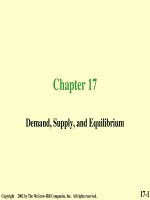Lecture Economics (6/e): Chapter 2 - Stephen L. Slavin
Bạn đang xem bản rút gọn của tài liệu. Xem và tải ngay bản đầy đủ của tài liệu tại đây (380.16 KB, 36 trang )
Chapter 2
Resource Utilization
Copyright 2002 by The McGrawHill Companies, Inc. All rights reserved.
21
Chapter Objectives
•
•
•
•
•
•
•
•
•
Definition of economics
Central fact of economics
The four economic resources
Opportunity cost
Full employment
Full production
Productive and allocative efficiency
Enabling the economy to grow
The law of increasing cost
Copyright 2002 by The McGrawHill Companies, Inc. All rights reserved.
22
Economics Defined
• Economics is the efficient allocation of
the scarce means of production toward
the satisfaction of human wants
– The means of production are limited
– Human wants are unlimited
Copyright 2002 by The McGrawHill Companies, Inc. All rights reserved.
23
The Central Fact of Economics Is
SCARCITY
• Scarcity
– Resources are the things society uses to
produce goods and services
• These resources are scarce (limited)
• The economic problem
– There are never enough resources to
produce all of the goods and services that
people want
Copyright 2002 by The McGrawHill Companies, Inc. All rights reserved.
24
Four Economic Resources
•
•
•
•
Land
Labor
Capital
Entrepreneurial ability
Copyright 2002 by The McGrawHill Companies, Inc. All rights reserved.
25
Land
– Includes natural resources such as
timber, oil, coal, iron ore, soil, water,
as well as the ground in which these
resources are found
– Is used for the extraction of minerals
and farming
– Provides the site for factories, office
buildings, shopping centers, homes,
etc.
– Produces “rent”
Copyright 2002 by The McGrawHill Companies, Inc. All rights reserved.
26
Labor
– The work and time for which one is
paid is what economists call “labor”
– Money received for one’s labor is
called wages and/or salaries
– About twothirds of the total resource
cost is the cost of labor
Copyright 2002 by The McGrawHill Companies, Inc. All rights reserved.
27
Capital
– Manmade goods used to produce
other goods or services is what
economists call “capital”
• Examples are office buildings, stores,
and factories
– The money owners of “capital” receive
is called “interest”
– Capital is the MOST important of the
four economic resources
Copyright 2002 by The McGrawHill Companies, Inc. All rights reserved.
28
Entrepreneurial Ability
• The entrepreneur
–
–
–
–
Sets up a business
Assembles the needed resources
Risks his/her own (or borrowed) money
Makes a “profit” or incurs a “loss”
• Is central to the American economy
– 23 million businesses are virtually all
entrepreneurs
• The vast majority work for themselves or have
one or two employees
Copyright 2002 by The McGrawHill Companies, Inc. All rights reserved.
29
Our Economic Problem
Revisited
• Limited resources versus unlimited wants
• There are NOT enough resources to
produce everything that everyone wants
• Therefore, CHOICES must BE MADE!
• Every CHOICE has an OPPORTUNITY
COST associated with it!
Copyright 2002 by The McGrawHill Companies, Inc. All rights reserved.
210
Opportunity Cost: An Important,
Fundamental Concept in Economics
• Because we cannot have everything we
want, we must make choices
• The thing we give up (our secondbest
choice) is called the opportunity cost of
our choice
– This is the foregone value of the next best
alternative
• In the economic world, “both” is not an
admissible answer to a choice of “which
one”
Copyright 2002 by The McGrawHill Companies, Inc. All rights reserved.
211
Highest Valued Alternative
• Options
–
–
–
–
Watch TV
Talk on the telephone
Go on a date
Study economics
Choice made
Highest valued alternative
• The opportunity cost here is the highest valued
alternative that could have been chosen (i.e.,
study economics)
Copyright 2002 by The McGrawHill Companies, Inc. All rights reserved.
212
Inherit $40,000
Two choices – buy a car or go to college
• Bought the car
– (Paid $40,000)
• Can’t go to college
College graduate (lifetime earnings) $1,300,000
High School graduate (lifetime earnings) 800,000
Opportunity Cost
$ 500,000
Copyright 2002 by The McGrawHill Companies, Inc. All rights reserved.
213
California
19671997
• Prisons
– Added 21
additional prisons
• Colleges
– Added 1
additional college
The Opportunity Cost of building more
prisons is building fewer colleges
Copyright 2002 by The McGrawHill Companies, Inc. All rights reserved.
214
California
1990 1997
• Prison guards
+ 10,000
• College employees
10,000
Obviously, the opportunity cost of one
additional prison is guard is one college
employee
Copyright 2002 by The McGrawHill Companies, Inc. All rights reserved.
215
Full Employment
• A five percent unemployment rate
1
1 From 1971 – 1996 the unemployment rate was above 5%. In
recent years, this has hovered above 4 %. If it stays this low, the
next edition of the textbook may adjust this to 4 %
Copyright 2002 by The McGrawHill Companies, Inc. All rights reserved.
216
Full Production
• An eightyfive to ninety percent
utilization rate
Copyright 2002 by The McGrawHill Companies, Inc. All rights reserved.
217
Underemployment of
Resources
•
•
•
•
•
•
An unemployment rate greater than 5%
A capacity utilization rate less than 85%
Blue laws
Federal and state laws
Night and weekend work
Discrimination
– A phenomenon that has diminished but has not been
eliminated entirely
– Probably keeps our output 10 15% below what it
could be
• If there was truly an efficient allocation of resources
Copyright 2002 by The McGrawHill Companies, Inc. All rights reserved.
218
Production Possibilities
Frontier
• Represents our economy at
– Full employment
– Full production
Copyright 2002 by The McGrawHill Companies, Inc. All rights reserved.
219
Production Possibilities
Curve
16
A
B
14
Hypothetical Production Schedule
Point Units of Butter Units of Guns
A 15 0
B 14 1
C 12 2
D 9 3
E 5 4
F 0 5
C
12
10
D
8
6
E
4
2
0
F
1
2
3
4
5
6
Units of guns
The Production Possibilities Frontier (PPF) measures the quantity of two
goods that an economy or business is capable of producing with its current
available resources and technology
Copyright 2002 by The McGrawHill Companies, Inc. All rights reserved.
220
Production Possibilities
Curve
Had to give up 1 unit of butter
16
A
B
14
Hypothetical Production Schedule
Point Units of Butter Units of Guns
A 15 0
B 14 1
C 12 2
D 9 3
E 5 4
F 0 5
In this particular instance, the opportunity cost
of gaining one unit of guns was one unit of
butter
C
12
10
D
8
6
E
4
2
0
F
1
2
3
4
5
6
Units of guns
To gain 1 unit of Guns
When you are on the line (PPF), to get more of one thing you have to give
up some of the other thing
Copyright 2002 by The McGrawHill Companies, Inc. All rights reserved.
221
Production Possibilities
Curve
Had to give up 2 units of butter
16
A
B
14
Hypothetical Production Schedule
Point Units of Butter Units of Guns
A 15 0
B 14 1
C 12 2
D 9 3
E 5 4
F 0 5
In this particular instance, the opportunity cost
of gaining one unit of guns was two units of
butter
C
12
10
D
8
6
E
4
2
0
F
1
2
3
4
5
6
Units of guns
To gain 1 unit of Guns
When you are on the line (PPF), to get more of one thing you have to give
up some of the other thing
Copyright 2002 by The McGrawHill Companies, Inc. All rights reserved.
222
Production Possibilities
Curve
Had to give up 3 units of butter
16
A
B
14
Hypothetical Production Schedule
Point Units of Butter Units of Guns
A 15 0
B 14 1
C 12 2
D 9 3
E 5 4
F 0 5
In this particular instance, the opportunity cost
of gaining one unit of guns was three units of
butter
C
12
10
D
8
6
E
4
2
0
F
1
2
3
4
5
6
Units of guns
To gain 1 unit of Guns
When you are on the line (PPF), to get more of one thing you have to give
up some of the other thing
Copyright 2002 by The McGrawHill Companies, Inc. All rights reserved.
223
Production Possibilities
Curve
Had to give up 4 units of butter
16
A
B
14
Hypothetical Production Schedule
Point Units of Butter Units of Guns
A 15 0
B 14 1
C 12 2
D 9 3
E 5 4
F 0 5
In this particular instance, the opportunity cost
of gaining one unit of guns was four units of
butter
C
12
10
D
8
6
E
4
2
0
F
1
2
3
4
5
6
Units of guns
To gain 1 unit of Guns
When you are on the line (PPF), to get more of one thing you have to give
up some of the other thing
Copyright 2002 by The McGrawHill Companies, Inc. All rights reserved.
224
Production Possibilities
Curve
Had to give up 5 units of butter
16
A
B
14
Hypothetical Production Schedule
Point Units of Butter Units of Guns
A 15 0
B 14 1
C 12 2
D 9 3
E 5 4
F 0 5
In this particular instance, the opportunity cost
of gaining one unit of guns was five units of
butter
C
12
10
D
8
6
E
4
2
0
F
1
2
3
4
5
6
Units of guns
To gain 1 unit of Guns
When you are on the line (PPF), to get more of one thing you have to give
up some of the other thing
Copyright 2002 by The McGrawHill Companies, Inc. All rights reserved.
225









